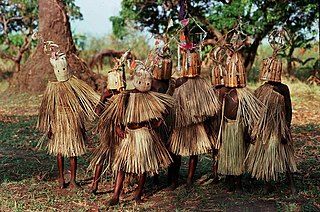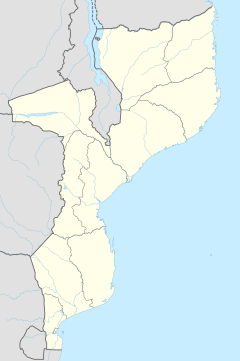
Niassa is a province of Mozambique. It has an area of 129,056 km2 and a population of 1,810,794 (2017). It is the most sparsely populated province in the country. Lichinga is the capital of the province. There are a minimum estimated 450,000 Yao people living in Mozambique. They largely occupy the eastern and northern part of the Niassa province and form about 40% of the population of Lichinga, the capital of this province.

Ruvuma River, formerly also known as the Rovuma River, is a river in the African Great Lakes region. During the greater part of its course, it forms the border between Tanzania and Mozambique. The river is 800 kilometres (497 mi) long, with a drainage basin of 155,500 square kilometres (60,000 sq mi) in size. Its mean annual discharge is 475 m³/s at its mouth.
The Diocese of Niassa it is one of the three Anglican dioceses of Mozambique, part of the Anglican Church of Mozambique and Angola. This diocese is geographically the central of the three, the others being the Diocese of Lebombo and the Diocese of Nampula.

The Yao people, waYao, are a major Bantu ethnic and linguistic group based at the southern end of Lake Malawi, who played an important part in the history of Southeast Africa during the 19th century. The Yao are a predominantly Muslim people of about 2 million spread over three countries, Malawi, northern Mozambique, and in Ruvuma Region and Mtwara Region of Tanzania. The Yao people have a strong cultural identity, which transcends the national borders.

Lichinga is the capital city of Niassa Province of Mozambique. It lies on the Lichinga Plateau at an altitude of 1,360 metres (4,460 ft), east of Lake Niassa. The town was founded as Vila Cabral as a farming and military settlement. It is served by Lichinga Airport.

The Niassa Company or Nyassa Chartered Company was a royal company in the Portuguese colony of Mozambique, then known as Portuguese East Africa, that had the concession of the lands that include the present provinces of Cabo Delgado and Niassa between 1891 and 1929.
Articles related to Mozambique include:

The wildlife of Mozambique consists of the flora and fauna of this country in southeastern Africa. Mozambique has a range of different habitat types and an ecologically rich and diverse wildlife. This includes 236 species of mammal, 740 species of bird and 5,692 species of vascular plant. The Maputaland-Pondoland-Albany hotspot, with significantly high levels of biodiversity, stretches from the southern tip of Mozambique into northeastern South Africa.
Yao is a Bantu language in Africa with approximately two million speakers in Malawi, and half a million each in Tanzania and Mozambique. There are also some speakers in Zambia. In Malawi, the main dialect is Mangochi, mostly spoken around Lake Malawi. In Mozambique, the main dialects are Makale and Massaninga. The language has also gone by several other names in English, including chiYao or ciYao, Achawa, Adsawa, Adsoa, Ajawa, Ayawa, Ayo, Ayao, Djao, Haiao, Hiao, Hyao, Jao, Veiao, and waJao.

The Unity Bridge across Ruvuma River at Negomano, Mozambique, between Tanzania and Mozambique, was proposed as early as 1975, shortly after Mozambique's independence. It was the idea of the two countries' former Presidents, Mwalimu Nyerere and Samora Machel. Several design studies and limited construction work were completed in the early 1980s, but the Unity Bridge was not finished due to lack of funds.

Niassa Reserve is a nature reserve in Cabo Delgado Province and Niassa Province, Mozambique. Covering over 42,000 square kilometres, it is the largest protected area in the country. The reserve is part of the Trans-Frontier Conservation Area and links to the Tanzanian Lukwika-Lumesule Game Reserve. It will connect to the Lake Niassa Reserve when it is completed.

Lago District is a district of Niassa Province in north-western Mozambique. The principal town is Metangula. Lago District is bordered to the west by Lake Nyasa, on the south by Lichinga, on the east by Sanga District. Lago shares its northern boundary with Tanzania.

The Lugenda or Lujenda is a river of northern Mozambique. It flows in a south-north direction from Lake Amaramba/Lake Chiuta and is the largest tributary of the Ruvuma River. It joins the Luambala River at 13°26′12″S36°18′20″E. The river valley is reported to be only 800 feet (240 m) above sea level. North of Lake Chiuta, those on the west bank call it the Msambiti River. At one point, the Lugenda splits into several streams with islands between them, some of whom are populated such as the island Achemponda.

Niassodon is an extinct genus of kingoriid dicynodont therapsid known from the Late Permian of Niassa Province, northern Mozambique. It contains a single species, Niassodon mfumukasi.

Ngalue Cave is an archaeological site located in the Niassa province of Mozambique. Excavated primarily by Julio Mercader in 2007, Ngalue is a Middle Stone Age site. Due to its relatively dry environment and the shape of the cave, Ngalue had very good preservation and not only were stone tools and animal bones found. There were preserved starch grains on many of the stone tools as well. Overall, this site can help add to our knowledge of the Middle Stone Age site in the Niassa valley and to our understanding of the subsistence of Middle Stone Age peoples in Eastern Africa as a whole.
Vicente Msosa is a Mozambican Anglican bishop. He has been the bishop of the Diocese of Niassa, in Mozambique, at the Anglican Church of Southern Africa, since 1 April 2017. He was installed the youngest bishop of the Anglican Communion, aged 35 years old. He is married to Anastacia and they have three children.

The Njesi Highlands are a range of mountains in northern Mozambique.

The Anglican Church of Mozambique and Angola [Igreja Anglicana de Moçambique e Angola (IAMA)] is a newly created and the 42nd ecclesiastical province of the world-wide Anglican Communion. Previously the dioceses which constitute this new province were parts of the Anglican Church of Southern Africa. The new province adopted its constitution and canons at a special synod, and was formally inaugurated on 24 September 2021, in an online teleconference including Justin Welby, Archbishop of Canterbury, and Josiah Idowu-Fearon, Secretary-General of the Anglican Consultative Council.
The Lichinga Solar Power Station, is a planned 50 MW (67,000 hp) solar power plant in Mozambique. The solar farm is under development by a consortium comprising Gigawatt Global, a Dutch multinational IPP and the Anglican Church of Niassa, based in Niassa Province, in northwestern Mozambique. The energy generated here is to be sold to Electricidade de Moçambique (EDM), the Mozambican public electric utility company, for distribution to Lago District, Mecula District, Mecanhelas District, Mavago District and Mandimba District.













